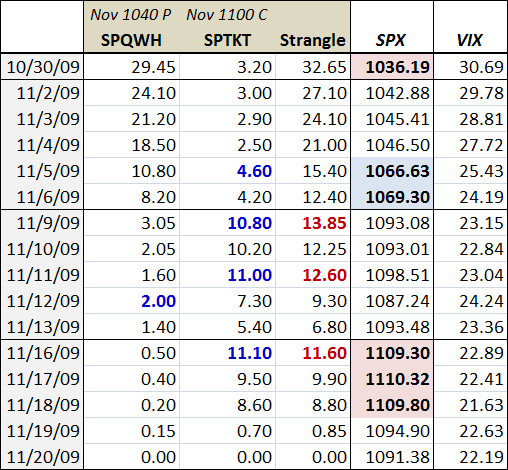SPX Strangle Pong Post-Mortem
When I first broached the idea of Strangle Pong (a strategy of selling a front month strangle in the SPX one leg at a time), I had every intention of periodically following up to offer comments on the strategy, how it was or was not working, and how a trader might manage a position like the one discussed in order to minimize risk while realizing a large amount of the profit potential.
In Strangle Pong Update, Mark Wolfinger (Options for Rookies) and I discussed the advisability of closing out the short put trade and taking some rather substantial profits. We agreed that keeping the position open in hopes of securing the final 3.65 in profit was not an attractive risk-reward play, particularly since the position had already earned 20.35 in profits. I concluded, however, that “for educational purposes I will opt to keep this an open item on the blog.” When I made that comment, I did not realize that an upcoming trip to Hawaii (the Big Island, where everyone who has an opportunity to do so should ignore the cost and take the helicopter tour of Kilauea) would keep me off the communications grid. What I am left with at this juncture is not the real-time analysis that I had hoped for, but a post-mortem. Usually I would not think a post-mortem would be as instructive, but in this case, I think there are quite a few lessons to learn.
For starters, while it turns out that my original rationale for the trade was rewarded at expiration, the risks along the way did not warrant holding through expiration, at least for me. This is an important point for beginning options traders, who have a tendency to hold their winning and losing options trades through expiration, usually resulting in winning trades giving back some of their earlier profits and all too often losing trades expiring worthless.
To recap, the idea behind the short strangle was to capitalize on the possibility of range-bound trading in the SPX in the 1040-1100 area during the last 16 days of the expiration cycle. The objective was to leg into the trade based on which end of the range the SPX was trading. The first leg was a short November SPX 1040 put that immediately went in the wrong direction. As the table below shows, the SPX broke 1040 and closed at 1036 and change (red shading) on the day the trade was initiated. With a maximum gain of 24 points, the trade was already a 5.45 point loss at the end of the first day. More importantly, a critical part of the trade thesis – that 1040 would provide support – was no longer valid. The bottom line is that there was very good reason to cut losses on day one and close out the trade.
As it turns out, my market timing signals earned their keep the next day as buyers jumped in, with support coming in the 1029-1030 area and the SPX beginning an almost uninterrupted bullish run for the next 13 trading days. After 5-6 days, the SPX had recovered to the middle of the target 1040-1100 trading range (blue shading) and two thirds of the potential profit had already been realized.
The week prior to expiration saw the SPX take a run at 1100 and just fall short. During that week, the 1040 puts fell all the way down to 1.40, while the November 1100 calls moved up in price on Monday and Wednesday (bold blue type). The short 1100 call position that Mark and I discarded as too risky on Monday at 8.40 would have been a loser from Monday through Thursday. While the short 1100 call eventually became profitable on Friday, the following week the SPX broke out over 1100 and closed near 1110 on Monday, Tuesday and Wednesday, with the calls still unprofitable and threatening to incur larger losses.
Getting back to the original rationale for the trade, once the SPX closed above 1100 on Monday, upside resistance was broken and the risk was too high for a relatively small reward. At that stage – and with only four days remaining prior to expiration, I would have closed the trade at a loss of 3.20.
So to recap, while this looks like a perfect short strangle on paper, with both the short put and the short call expiring worthless, prudent risk management would not have resulted in holding the trade until expiration. Further, not only would the profits on the short put have been taken early (netting 20.35 out of a possible 24.00), but if the short call leg had been initiated (and I thought this was a questionable trade at the time of the Strangle Pong Update), I would certainly have cut my losses (-3.20) before giving the trade a chance to make a profit.
The bottom line is that this was a great trade on paper, but with proper risk management, is was merely a very good trade in terms of profits, netting only about 60% of what would have been earned if the strangle had been held to expiration. Over the long run, however, I maintain that understanding the risk-reward profiles of existing options positions is more important than trying to extract the maximum profit from each options trade.
For the two previous posts in this series, readers are encouraged to check out:


